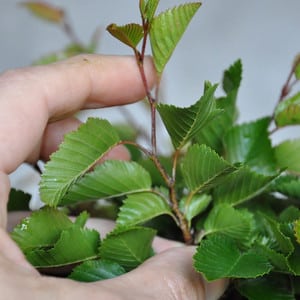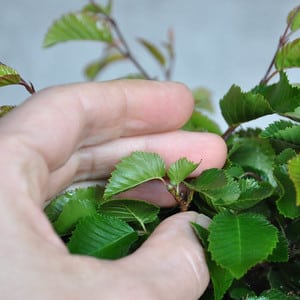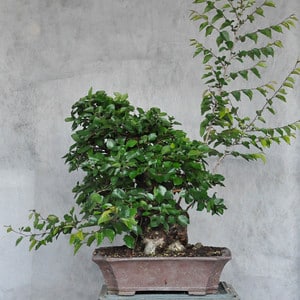Korean hornbeam is one of my favorite varieties for bonsai. I find them beautiful and rewarding to work with. And vigorous – healthy specimens tend to get shaggy this time of year. My tree was due for a haircut.

Side view, before
As is the case with a number of deciduous varieties, I let the spring shoots elongate to roughly 5 new leaves before cutting them back to two. This will help the tree develop the fine ramification that shows so well in winter.

New shoot

Shoot trimmed to leave two new leaves
I’m looking forward to seeing how the tree buds back this year. Although we’re off to a cool start, the weather has been nice lately which has kicked a number of trees into gear. The warmer the next few months, the better the tree will look this winter, and the closer the tree will come to its first exhibit.

Side view, after
You may have noticed that I missed a few shoots. There are several large wounds in the trunk – the vigorous shoots are temporary help enlisted to close them. Every couple of years I remove them and let new shoots continue the work. That way the helping branches don’t leave large wounds behind when they are removed.
Subscribe to Bonsai Tonight
New Posts Delivered Every Tuesday and Friday
Josef says
Wonderful tree and photography! I too love hornbeams, especially the Korean variety. Do you happen to have a picture of this particular tree in the winter showing its branching? Thanks for this exceptional blog and, please, keep it up!
xwires says
Thanks Josef – I have plenty of pics that show off the tree without leaves as well as shots that detail its development over time. I’m planning a more full article in the future that tells more of the tree’s story and will post the leafless shots then.
Best,
Jonas
Aaron says
Hi Jonas… just found this amazing blog 🙂
I was wondering if defoliation is used in the development of korean hornbeam?
I find that mine doesn’t respond predictably to branch defoliation (it’s not at the stage of defoliating the whole tree yet)… sometimes it pops out new leaves right away, sometimes it takes very very long.
Maybe I just haven’t found the ideal time to defoliate it?
xwires says
Hi Aaron,
I don’t know if it’s typically done or not – I’ll defer to the experts on that. Because my tree ramifies well on its own and isn’t yet full enough to necessitate full defoliation I haven’t had cause to give it a try. And while I’ve had decent results defoliating my trident maple, I usually leave the weaker areas alone and focus on slowing down the more vigorous growth.
xwires says
An update on defoliating Korean Hornbeam: turns out this is commonly done in Japan. Akio Kondo recommended it for a slightly more developed than mine. May or June are good times for this – July is a bit late. I’ll likely try partially defoliating my hornbeam next year to see how it responds. Some work that is common in Japan must be approached with caution here because our weather is different. Until I know that hornbeams respond well to defoliating here I’ll take it a step at a time.
benjamin carrillo says
hello i get a bonsai’s seed, but i don’t know how can i make them germinate.
i get it for almost a year , i did everything they suggested me , but still nothing.
i looking for an idea .
i will be greafull .
thanks
xwires says
Hi Benjamin – If the seed hasn’t sprouted for a year, it may not sprout ever. It might be time to try again!